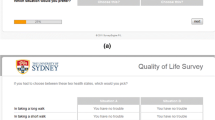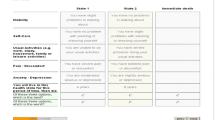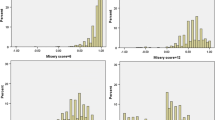Abstract
Background
In health state valuation studies, health states are typically presented as a series of sentences, each describing a health dimension and severity ‘level’. Differences in the severity levels can be subtle, and confusion about which is ‘worse’ can lead to logically inconsistent valuation data. A solution could be to mimic the way patients self-report health, where the ordinal structure of levels is clear. We develop and test the feasibility of presenting EQ-5D-5L health states in the ‘context’ of the entire EQ-5D-5L descriptive system.
Methods
An online two-arm discrete choice experiment was conducted in the UK (n = 993). Respondents were randomly allocated to a control (standard presentation) or ‘context’ arm. Each respondent completed 16 paired comparison tasks and feedback questions about the tasks. Differences across arms were assessed using regression analyses.
Results
Presenting health states ‘in context’ can significantly reduce the selection of logically dominated health states, particularly for labels ‘severe’ and ‘extreme’ (χ2 = 46.02, p < 0.001). Preferences differ significantly between arms (likelihood ratio statistic = 42.00, p < 0.05). Comparing conditional logit modeling results, coefficients are ordered as expected for both arms, but the magnitude of decrements between levels is larger for the context arm.
Conclusions
Health state presentation is a key consideration in the design of valuation studies. Presenting health states ‘in context’ affects valuation data and reduces logical inconsistencies. Our results could have implications for other valuation tasks such as time trade-off, and for the valuation of other preference-based measures.



Similar content being viewed by others
Notes
We acknowledge that the question “which do you prefer” may be considered more appropriate for such a preference task, but more important for this study was to mimic the standard presentation of this valuation task that is utilized for the EQ-5D, which uses this wording.
33344 describes a health state involving moderate problems with mobility, self-care and usual activities, and severe problems with pain/discomfort and anxiety/depression. 33355 describes a health state involving moderate problems with mobility, self-care and usual activities, and extreme problems with pain/discomfort and anxiety/depression.
References
Stolk, E.A., Oppe, M., Scalone, L., Krabbe, P.F.: Discrete choice modeling for the quantification of health states: the case of the EQ-5D. Value Health 13(8), 1005–1013 (2010)
Krabbe, P.F., Devlin, N.J., Stolk, E.A., Shah, K.K., Oppe, M., Van Hout, B., Quik, E.H., Pickard, A.S., Xie, F.: Multinational evidence of the applicability and robustness of discrete choice modeling for deriving EQ-5D-5L health-state values. Med. Care 52(11), 935–943 (2014)
Dolan, P.: Modeling valuations for EuroQol health states. Med. Care 35(11), 1095–1108 (1997)
Brazier, J., Roberts, J., Deverill, M.: The estimation of a preference-based measure of health from the SF-36. J. Health Econ. 21(2), 271–292 (2002)
Herdman, M., Gudex, C., Lloyd, A., Janssen, M., Kind, P., Parkin, D., Bonsel, G., Badia, X.: Development and preliminary testing of the new five-level version of EQ-5D (EQ-5D-5L). Qual. Life Res. 20(10), 1727–1736 (2011)
Mulhern, B., Bansback, N., Brazier, J., Buckingham, K., Cairns, J., Devlin, N., Dolan, P., Hole, A.R., Kavetsos, G., Longworth, L.: Preparatory study for the revaluation of the EQ-5D tariff: methodology report. Health Technol. Assess. 18(12), 1–192 (2014)
Craig, B.M., Pickard, A.S., Rand-Hendriksen, K.: Do health preferences contradict ordering of EQ-5D labels? Qual. Life Res. 24(7), 1759–1765 (2015)
Santos, M., Monteiro, A.L., Craig, B.M.: Further evidence on EQ-5D-5L preference inversion: A Brazil/US collaboration. In: Paper presented at the 32nd EuroQol scientific plenary meeting. Krakow, 10–11 September (2015)
Norman, R., Cronin, P., Viney, R.: A pilot discrete choice experiment to explore preferences for EQ-5D-5L health states. Appl. Health Econ. Health Policy 11(3), 287–298 (2013)
Oppe, M., Devlin, N.J., van Hout, B., Krabbe, P.F., de Charro, F.: A program of methodological research to arrive at the new international EQ-5D-5L valuation protocol. Value Health 17(4), 445–453 (2014)
Spalek, T.M., Hammad, S.: The left-to-right bias in inhibition of return is due to the direction of reading. Psychol. Sci. 16(1), 15–18 (2005)
Bansback, N., Brazier, J., Tsuchiya, A., Anis, A.: Using a discrete choice experiment to estimate health state utility values. J. Health Econ. 31(1), 306–318 (2012)
Hole, A.R.: CLOGITHET: Stata module to estimate heteroscedastic conditional logit model. Statistical software components. Boston College Department of Economics, Chestnut Hill (2009)
Hole, A.R.: Small-sample properties of tests for heteroscedasticity in the conditional logit model. Econ. Bull. 3(18), 1–14 (2006)
Devlin, N., Shah, K., Feng, Y., van Hout, B.: Valuing health-related quality of life: An EQ-5D-5L value set for England. OHE research paper 16/01. Office of Health Economics, London (2016)
Office for National Statistics: census, population estimates by single year of age and sex for local authorities in the United Kingdom (2011). http://www.ons.gov.uk/. Accessed 23 Oct 2014
Jonker, M., Donkers, B., de Bekker-Grob, E., Stolk, E.: The impact of attribute-level overlap (and color coding) on response efficiency in discrete choice experiments. In: Paper presented at the 33rd EuroQol plenary meeting. Berlin, 15–16 September (2016)
Viney, R., Mulhern, B., Norman, R., Shah, K., Longworth, L., Bansback, N.: Using DCE with duration to value EQ-5D-5L: Exploring the impact of task presentation. In: Paper presented at the 33rd EuroQol plenary meeting. Berlin, 15–16 September (2016)
Norman, R., King, M.T., Clarke, D., Viney, R., Cronin, P., Street, D.: Does mode of administration matter? Comparison of online and face-to-face administration of a time trade-off task. Qual. Life Res. 19(4), 499–508 (2010)
Mulhern, B., Longworth, L., Brazier, J., Rowen, D., Bansback, N., Devlin, N., Tsuchiya, A.: Binary choice health state valuation and mode of administration: head-to-head comparison of online and CAPI. Value Health 16(1), 104–113 (2013)
Oppe, M., Rand-Hendriksen, K., Shah, K., Ramos-Goñi, J.M., Luo, N.: EuroQol protocols for time trade-off valuation of health outcomes. PharmacoEconomics 34(10), 993–1004 (2016)
Acknowledgements
This study was funded by the EuroQol Research Foundation. However, the views expressed do not necessarily reflect the views of the EuroQol Research Foundation. We would like to thank Richard Norman for his constructive comments on an earlier version of this paper, and are grateful for feedback obtained from participants at the EuroQol Scientific Plenary Meeting and the International Society for Pharmacoeconomics and Outcomes Research (ISPOR) congress, where earlier versions of the paper were presented. We would also like to thank Rob White from EpiGenesys for survey development, and Andreea Sisman, Oana Baraitarus and colleagues at Survey Sampling International (SSI) for the recruitment of respondents.
Author information
Authors and Affiliations
Corresponding author
Ethics declarations
Conflict of interest
Koonal Shah, Yan Feng, Brendan Mulhern, and Nancy Devlin are members of the EuroQol Group. There are no other relationships or potential conflicts of interest to declare.
Rights and permissions
About this article
Cite this article
Cole, A., Shah, K., Mulhern, B. et al. Valuing EQ-5D-5L health states ‘in context’ using a discrete choice experiment. Eur J Health Econ 19, 595–605 (2018). https://doi.org/10.1007/s10198-017-0905-7
Received:
Accepted:
Published:
Issue Date:
DOI: https://doi.org/10.1007/s10198-017-0905-7




